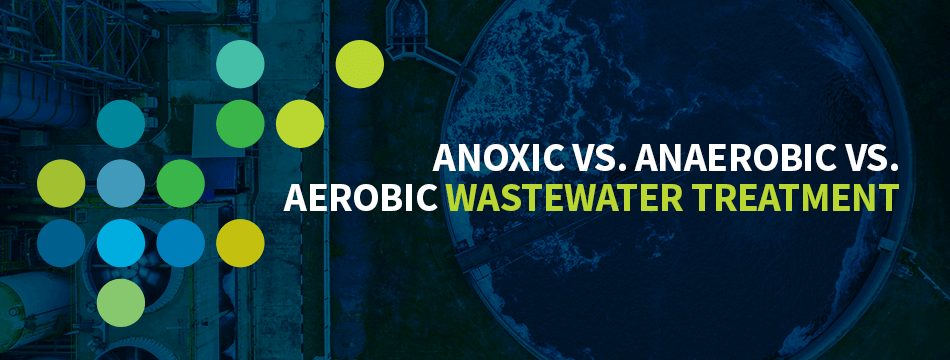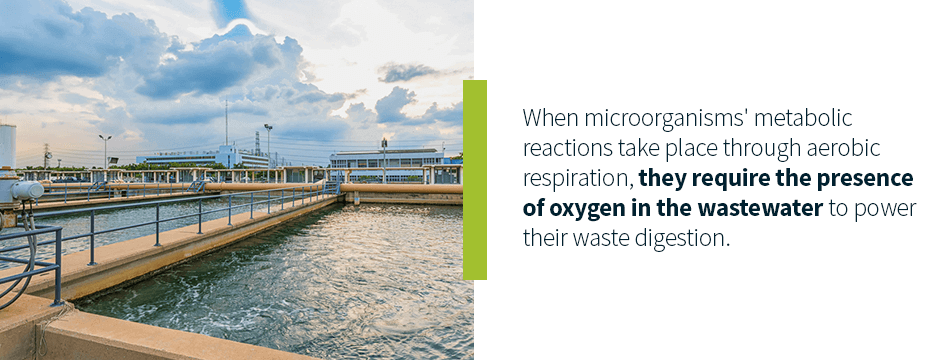Anoxic vs. Anaerobic vs. Aerobic Wastewater Treatment
By: Tom Frankel
Post Date: December 2nd 2020

Wastewater treatment encompasses numerous treatment methods, each with its own procedures, advantages, equipment, and outcomes. Keeping track of the various techniques and using them in the appropriate applications is essential. It helps plants get the most productivity out of a treatment system, comply with regulatory standards, and keep operating costs and time demands manageable.
The guide below will discuss anoxic, anaerobic, and aerobic conditions in wastewater treatment, explain how they differ, and describe how plants can best put these processes to work.
Table Of Contents
- WHAT DOES “ANOXIC” MEAN?
- WHAT ROLE DO ANOXIC CONDITIONS PLAY IN WASTEWATER TREATMENT?
- WHAT DOES “ANAEROBIC” MEAN?
- WHAT ROLE DOES ANAEROBIC TREATMENT PLAY IN WASTEWATER?
- WHAT DOES “AEROBIC” MEAN?
- WHAT ROLE DOES AEROBIC TREATMENT PLAY IN WASTEWATER?
- CHOOSING THE BEST SYSTEM FOR YOUR APPLICATION
What Does “Anoxic” Mean?
Anoxic conditions involve environments in which molecular or free oxygen (O2) is absent, though bound oxygen may be present. “Anoxic” refers to the state of the environment rather than microorganisms and their processes.
In wastewater treatment, anoxic conditions differ from anaerobic conditions based on the presence or absence of nitrogen. Though anoxic conditions do not contain molecular oxygen, they may contain nitrates or nitrites. Nitrates (NO3) and nitrites (NO2) both contain bound oxygen because they include oxygen molecules as part of their structures. An anoxic environment may include these compounds as long as it does not include free oxygen.
What Role Do Anoxic Conditions Play in Wastewater Treatment?
Anoxic zones in wastewater are useful for nitrogen removal. Some wastewater has a high nitrate and nitrite content, and the treatment process must break down those compounds to avoid causing nutrient pollution when the plant discharges its effluent back into the environment.
In anoxic zones, when bacteria break down the nitrogen products, the separation of the molecules releases oxygen, which the bacteria need to thrive. Because the biodegradation of nitrogen products naturally releases oxygen, the bacteria in anoxic tanks like denitrification basins do not require supplemental oxygen from diffusers or surface aerators.
What Does “Anaerobic” Mean?
“Anaerobic” describes the respiration processes of microorganisms. Anaerobic respiration occurs in the absence of oxygen.
During anaerobic processes, both free and bound oxygen are typically absent. Nitrates and nitrites do not usually exist in wastewater processes that use anaerobic bacteria — bacteria that do not require oxygen — for digestion. These conditions differ from anoxic environments, in which free oxygen is also absent but bound oxygen like that found in nitrates and nitrites may be present.
What Role Does Anaerobic Treatment Play in Wastewater?
During anaerobic wastewater treatment processes, microorganisms break down waste matter in the absence of oxygen. These processes often occur in an airtight, enclosed bioreactor filled with sludge. The sludge contains anaerobic bacteria and other beneficial microbes. In the bioreactor, the microorganisms digest the organic matter in the wastewater.
Below are a few different types of anaerobic wastewater treatment fixtures and how they work:
- Lagoons: Anaerobic lagoons are large ponds. Plants often use them as the first step in municipal sewage treatment, as well as for industrial and agricultural wastewater treatment. In the lagoons, wastewater settles into different layers, with liquid layered over the sludge to prevent oxygen from reaching it during microbial digestion.
- Sludge blanket reactors: Anaerobic sludge blanket reactors send wastewater through a floating blanket-like layer of sludge. As the wastewater passes through the sludge, anaerobic microbes digest the organic matter and settle to the bottom of the tank in chunks that the plant can recycle for other processes.
- Filter reactors: An anaerobic filter reactor uses a tank with an attached filter medium. Microorganisms affix themselves to the filter medium and form a biofilm. Once formed, the biofilm and its microbes are effective in breaking down organic matter in the wastewater.
What Does “Aerobic” Mean?
“Aerobic” also describes the respiration processes of microorganisms. Aerobic respiration occurs in the presence of oxygen. When microorganisms’ metabolic reactions take place through aerobic respiration, they require the presence of oxygen in the wastewater to power their waste digestion.

What Role Does Aerobic Treatment Play in Wastewater?
Aerobic treatment usually occurs as part of secondary treatment, after primary treatment has already filtered out much of the grit and large solid particles from the wastewater.
Aerobic wastewater treatment often uses equipment like surface aerators or diffusers to mix air into the water column. With surface aerators, the mechanical churning on the surface mixes oxygen into the wastewater. With diffusers, the bubbles of air that rise from the bottom of the tank facilitate oxygen transfer. The presence of oxygen stimulates beneficial oxygen-feeding bacteria, protozoa, and other microbes in the water to help treat the waste by breaking down organic matter.
Below are a few different aerobic wastewater processes and how they work:
- Activated sludge: The activated sludge process uses an aeration tank with aerators or diffusers. As the organic material in the waste breaks down, it forms large bacteria-containing chunks known as flocs. The flocs then settle to the bottom of the tank, where they are easy to remove. Wastewater treatment plants may then feed some of the resulting activated sludge back into earlier treatment processes so the bacteria can aid in waste breakdown.
- Fixed-bed bioreactors: Fixed-bed bioreactors (FBBRs) pack thousands of tiny components known as media into tight chambers. The media components remain immobile, and their ample surface area attracts microorganisms, which settle on the surfaces and form a biofilm. The microorganisms then help break down waste. Some of these chambers also allow for anoxic denitrification zones.
- Moving-bed bioreactors: Moving-bed bioreactors (MBBRs) use thousands of tiny media carriers suspended throughout the wastewater in a large tank. The suspended media carriers can float freely, and they create a hospitable growing environment for microorganisms. Because the media carriers provide extensive surface area for beneficial microbes to thrive on, they facilitate the digestion of organic waste matter.
- Membrane bioreactors: Membrane bioreactors (MBRs) use advanced technology that allows them to treat wastewater with very high suspended solids content. MBRs work by combining activated sludge processes with membrane filtration. They treat the waste by effectively separating and recycling the suspended solids.
Choosing the Best System for Your Application
When you’re thinking about how to choose which is best for your wastewater treatment system, remember that anaerobic processes are useful for wastewater that contains a high concentration of organic matter. For this reason, treatment plants often use anaerobic treatment first to remove a significant part of the wastewater’s organic matter before sending it on for further aerobic treatment.
The two methods are also useful independently. Anaerobic treatment is ideal for various different wastewater types, including agricultural, food and beverage, and pulp and paper and textile wastewater, as well as municipal sludge and sewage.
Aerobic wastewater treatment is also effective for a range of wastewater types, particularly those with lower biochemical oxygen demand (BOD) and chemical oxygen demand (COD). It is useful for chemical, manufacturing, food, and beverage, and oil and gas wastewater, as well as the waste from municipal industries.
In some cases, a combination of anoxic, aerobic, and anaerobic processes is ideal in wastewater treatment because it helps reduce sludge. Recent research suggests that alternating conditions can reduce the sludge yield of conventionally activated sludge (CAS) by up to 50%. Though activated sludge is often necessary for wastewater treatment, reducing its volume can lower a plant’s capital and operating costs.
Make SSI Aeration Your Trusted Source for All Types of Wastewater Treatment
To gain quality products and assistance in determining the best treatment for your waste operations, partner with SSI Aeration. SSI Aeration offers a variety of wastewater treatment solutions. We supply MBBR systems, disc diffusers, and tube diffusers, and our engineering teams have the industry expertise and problem-solving abilities to design full-scale systems and troubleshoot even the most challenging scenarios.
Contact us today to discuss a design, installation, or retrofit or learn more about what SSI Aeration can offer.

Mr. Frankel co-founded SSI in 1995 with experience in design and distribution of engineered systems. He is in charge of sales, marketing and operations in the company. Mr. Frankel holds multiple US patents related to diffusers. He is a graduate of Washington University in St. Louis.


